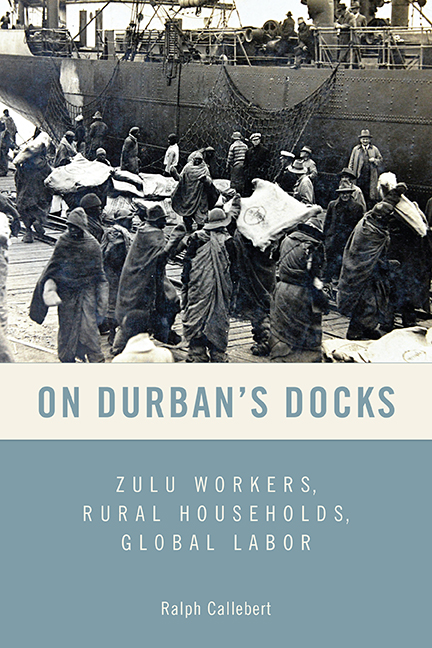Book contents
- Frontmatter
- Dedication
- Contents
- List of Maps
- Acknowledgments
- Abbreviations
- Introduction: Dock Workers in South African History
- 1 Dock Workers and the City, 1910s to 1950s
- 2 One Head of Cattle Named Salt, Another Named Beans: Livelihood Strategies in the 1950s
- 3 Work and Life between the City and the Countryside
- 4 My Children Never Went to Bed Hungry: Gender, Households, and Reproductive Labor
- 5 Cleaning the Wharves: Pilferage, Bribery, and Informal Trade
- 6 Buffaloes on Noah’s Ark: Reimagining Working-Class History
- Conclusion: Durban’s Dock Workers in Global Perspective
- Epilogue
- Notes
- Glossary
- Bibliography
- Index
- Frontmatter
- Dedication
- Contents
- List of Maps
- Acknowledgments
- Abbreviations
- Introduction: Dock Workers in South African History
- 1 Dock Workers and the City, 1910s to 1950s
- 2 One Head of Cattle Named Salt, Another Named Beans: Livelihood Strategies in the 1950s
- 3 Work and Life between the City and the Countryside
- 4 My Children Never Went to Bed Hungry: Gender, Households, and Reproductive Labor
- 5 Cleaning the Wharves: Pilferage, Bribery, and Informal Trade
- 6 Buffaloes on Noah’s Ark: Reimagining Working-Class History
- Conclusion: Durban’s Dock Workers in Global Perspective
- Epilogue
- Notes
- Glossary
- Bibliography
- Index
Summary
The mixed and complex livelihood strategies discussed in this book relied on some of the important advantages that casual dock labor offered. The work was hard, dangerous, and irregular, and, as Africans, workers received a fraction of the pay that their white colleagues received for generally much lighter work. However, these African migrant dock workers were also paid better than most Africans in the city, and the flexibility of casual dock labor, as well as their access to cargoes from which they could pilfer, allowed them to diversify their livelihoods. Many also lived in places where apartheid authorities could not police their lives as closely as they wanted to.
Many of these advantages disappeared in and after 1959, when dock labor was decasualized. Workers’ ability to use their bargaining power on a daily basis disappeared with the establishment of a hiring monopoly, they were increasingly forced into compounds, and they no longer had the flexibility to choose when to work or for which ship to show up to for hiring. After more than a century, the city's authorities and stevedoring employers had finally succeeded in exerting their control over this notoriously independent group of workers at the heart of the regional economy. In the preceding decades, these workers had walked off their jobs regularly, protesting their wage rates, working conditions, and pass laws, or defending the moral economy of the docks. In the decade after decasualization, however, hardly any significant industrial action took place. The introduction of shipping containers in the 1970s, reducing the sector's reliance on manual labor and making pilferage much more difficult, further undermined the agency of dock workers.
Just as migrant labor had turned from a source of opportunities into a form of compulsion and a cause of impoverishment, many of the opportunities that casual dock labor offered disappeared after the 1950s. The agency afforded by the strategies described in this book were ultimately tenuous and vulnerable. Apartheid authorities’ relentless attempts at rooting out independent African economic initiatives won out in the end. Nevertheless, such small-scale African businesses never entirely disappeared and would eventually develop into what became known as the “informal economy.” While a comprehensive array of repressive apartheid-era measures kept this sector small compared to the rest of the continent, it was never completely suppressed.
- Type
- Chapter
- Information
- On Durban's DocksZulu Workers, Rural Households, Global Labor, pp. 165 - 168Publisher: Boydell & BrewerPrint publication year: 2018

